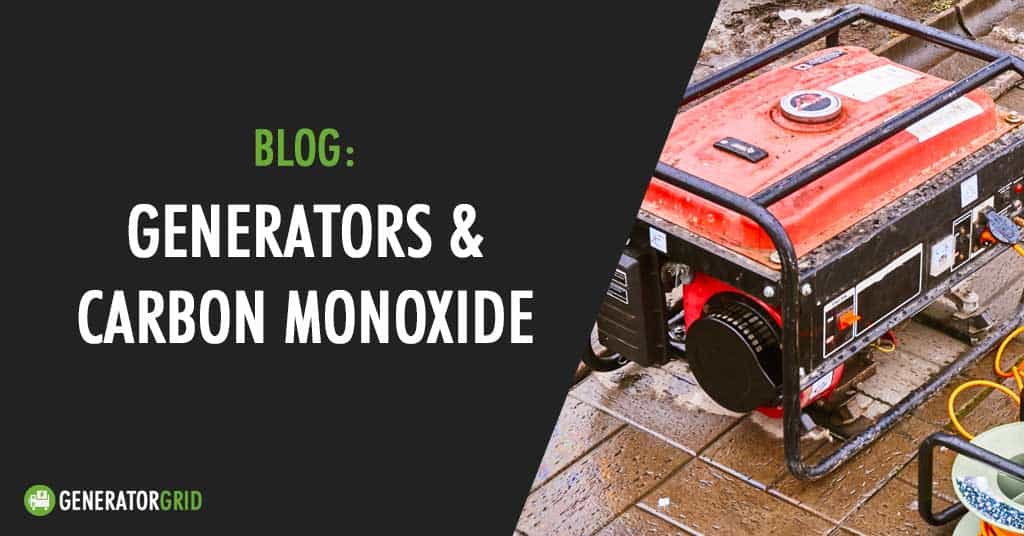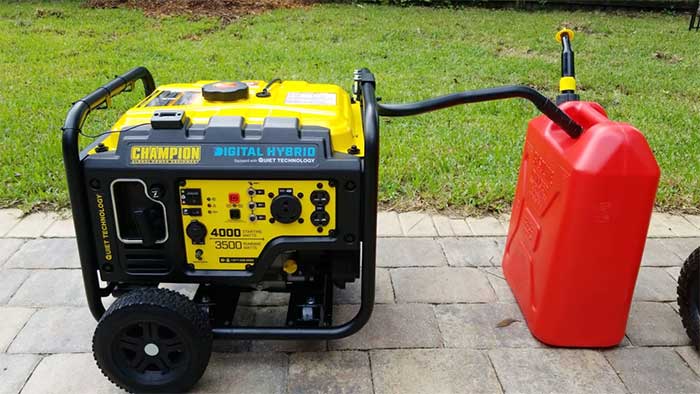Last Updated on July 25, 2022 by Manager Access

Using a portable generator can give you access to electrical power during an emergency, when you’re camping, or on a work site.
However, using your portable generator incorrectly could also potentially give you carbon monoxide poisoning.
Since safely operating your portable generator is key, I’m going to tell you how you can be sure that you’ll get the most out of your unit, sans carbon monoxide poisoning.
When operated improperly, a portable generator can emit carbon monoxide fumes that can be harmful or even deadly.
To avoid this, you’ll want to only use your generator in a well-ventilated area with the exhaust pointing away from you. If you’re using your generator to power your home, you should keep it outside and invest in a carbon monoxide detector.

If you’re wondering how to use your portable generator safely, there are a few things that you’ll need to know.
During storms like hurricanes, portable generators can be an essential tool.
They can keep your home powered even when the electrical grid is out or your power lines have gone down.
Sadly, with just about every hurricane in the United States, one or two people who’ve never used a portable generator before will perish from toxic carbon monoxide fumes.
This tragedy could easily be avoided with a little bit of information and training.
In this article, we will go over how to safely use your portable generator, how much ventilation you really need, what safety precautions that you can take to keep yourself and your family safe.
I will suggest a few devices are best suited for detecting the carbon monoxide that your portable generator’s exhaust emits.
Understanding Carbon Monoxide
In the United States alone, more than 400 people die every year as a direct result of inhaling carbon monoxide fumes unintentionally for too long.
It’s a good idea to understand what carbon monoxide is, why its deadly, and what to look out for.
This is a life skill that you can use to help keep yourself and others safe whether you’re using a portable generator or not.
What Is Carbon Monoxide?
 Carbon monoxide (CO) is a toxic gas that is produced by the incomplete combustion of carbon.
Carbon monoxide (CO) is a toxic gas that is produced by the incomplete combustion of carbon.
This means that any combustible carbon-based fuel is capable of producing carbon monoxide gas.
Carbon monoxide is slightly less dense than air. Carbon monoxide is usually produced when there is not enough oxygen available to make carbon dioxide, or CO2.
This usually happens with combustion engines (like the one in your portable generator) but can also happen when burning fuel in a contained space like with a gas oven.
Why is it so dangerous?
Carbon monoxide is colorless, odorless, tasteless, and invisible.It’s also highly toxic to any living creature that breathes oxygen, meaning animals and humans.
There’s a myth that carbon monoxide may have a slight “gassy” smell. This isn’t necessarily true.
Many people never smell a thing and then out of nowhere, their carbon monoxide monitor goes off.
Carbon monoxide is very dangerous because it quickly combines with hemoglobin (found in your blood) and creates a compound known as carboxyhemoglobin.
If enough carbon monoxide is present, this can happen in minutes, stopping your blood from being properly oxygenated and shutting your body down.
Carbon monoxide poisoning can cause seizures, comas, or death. Concentrations as low as 667 ppm (parts-per notation) are fatal. For example, breathing in small amounts of carbon monoxide for around an hour, like in a workshop or factory, can cause severe illness.
Breathing it in in higher concentrations expedites this process.
OSHA recommends never exposing yourself to anything above 50 ppm.
The problem is, since you can’t detect carbon monoxide using your senses, you won’t even know its there.
You may feel confused and tired and decide to sit down. That’s when loss of consciousness occurs. In many cases, carbon monoxide poisoning happens when people are already asleep.
How do the symptoms of carbon monoxide poisoning present?
Symptoms may vary from individual to individual, but in general, carbon monoxide poisoning resembles other kinds of poisoning.Usually, the first physical symptom is a headache, followed by nausea, dizziness, vomiting, and fatigue.
Feelings of weakness and malaise are also common. Neurological symptoms usually start with confusion, followed by disorientation, visual disturbance, fainting, unconsciousness, and seizures.
Ultimately, people who have been exposed to unhealthy levels of carbon monoxide could have permanent heart or tissue damage, nervous system damage, and/or will die.
How to Use Your Portable Generator Safely And Avoid Carbon Monoxide Poisoning

Now that you’ve been adequately frightened by the dangers of carbon monoxide poisoning, let me brighten things back up. Carbon monoxide poisoning from a portable generator can easily be avoided. All you have to do is know how to run your generator correctly and follow the safety instructions provided in your user manual.
Thoroughly Read Your User Manual
First and foremost, you need to read your entire user manual.
The instructions that come with your portable generator aren’t suggestions or guidelines. They’re there to keep you safe.
Not every portable generator is the same. Engine styles and exhaust ports vary in numerous ways.
The amount of fuel your generator uses and its running time must also be considered. When it comes to adequate aeration and ventilation, one size does not fit all.
When in doubt, always err on the side of caution with any combustible engine.
If you don’t know how much ventilation your specific generator should have, take the safe route and keep it outside on your porch or in a generator housing with the exhaust port as far away from your home as possible facing in the other direction.
You need to keep it away from any windows, doors, and vents as well.
Check on Your Generator Before Your Run it and While it’s in Use
When you’re in the midst of a power outage or big storm, or when you’re using your generator on a job site and are busy working, it can be easy to forget all about your portable generator.
With longer running times and more fuel efficiency than ever before, portable generators can be very low maintenance machines.
However, this does not mean that you should just fill your generator with fuel and ignore it until it runs out of gas or propane.
Yes, I said propane. While propane isn’t quite as dangerous as gas because it burns cleaner, carbon monoxide can easily still be produced.
Even with the best portable generators, exhaust systems can become clogged or corroded.
With any engine, things can break. Before you even run your generator, inspect it for damage, corrosion, and fuel leaks.
Check out this OSHA link which will tell you exactly what to look for when checking on your portable generator.
Remember, even in a big storm, a portable generator should be kept as dry as possible. Water and electrical current don’t mix well.
Only Use Your Generator in a Well-Ventilated Area
When you’re running your portable generator, it’s critical that you keep it far enough away from your home and completely away from enclosed spaces.
All four sides of your generator must be open to fresh air.
This means that you have to keep it out of your garage and on top of your porch, not below it.
I get it, if it’s storming, you probably want to keep your generator dry and easily accessible.
I am not against this at all; keeping your generator clean and dry is important. That being said, there are ways that you can do this while still keeping it outside.
A generator tent, for example.
Storing your generator in your garage is fine, but when it’s time to turn it on, get it outside and keep it at least 6 feet away from your home and at least 10 feet away from any doors, windows, or vents in your home.
This may mean purchasing an extension cord.
Spending money on the right accessories and erring on the side of caution may seem a bit excessive, but as the saying goes, better to be safe than to be sorry.
When it comes to your health, safety, and the lives of those around you, don’t take any chances.
How to Minimize or Eliminate the Risks of Carbon Monoxide

Apart from running your generator properly, keeping it away from your home in a well-ventilated area, and making sure that you’re checking on it periodically, there are a few more things that you can do to ensure your safety and the safety of your others when running a portable generator.
Run Your Generator Outside
Look, I have heard it before and I am sure I will hear it again: “can’t I run my generator in my garage with the door open?”
My answer will always be the same: “no.”
running your car with the garage open isn’t even safe. Just because some people do it doesn’t mean that they should.
You need to have all four sides of your generator open and exposed to fresh air.
The air in your garage won’t give you adequate ventilation. Have you ever watched smoke swirl in a container? Have you ever been in a smoky room? If you have, you’ll be familiar with the way that smoke rises and fills a space.
It’s the same with carbon monoxide. Carbon monoxide fumes will rise, spread, and fill the volume of the container that they’re in.
This means that even if your garage has an open door, you’ll get a lot of fumes in one area. If your garage is attached to your house, carbon monoxide can seep into cracks, doors, and vents.
While I understand that you want to stay safe and dry in a storm, you should keep your generator outside. Grab an umbrella, wear a raincoat, heck, wear a helmet if you have to but don’t keep your generator in your home, garage, shed, or under your porch when it’s running.
Invest in A Carbon Monoxide Detector
Getting a carbon monoxide detector is a simple, smart, and easy way to protect yourself and your family from dangerous carbon monoxide fumes.
These devices have alarms that sound when they detect carbon monoxide in the air. Many are battery operated and very easy to use and install.
These devices can help detect carbon monoxide from any source, including a portable generator. It could save your life, simple as that.
Here’s a link to an inexpensive and reliable carbon monoxide alarm that could help to keep you safe from carbon monoxide poisoning.
Conclusion
As long as you’re operating your generator properly in a well-ventilated area, or better yet, outside with the exhaust facing away from your home, you probably won’t have to worry about getting carbon monoxide poisoning.
Still, it’s always a good idea to stay on your toes and be aware of the risks of operating any kind of machinery.
What tips do you have for people looking to operate their generator in a safer way? Is there anything missing from this article? Please feel free to comment, share, and leave your feedback!

Scott Krager purchased generatorgrid.com in the summer of 2020 and quickly began to buy every generator under the sun! He currently has over a dozen generators and the number is growing quickly. He lives in Portland, OR near his family and friends.
GeneratorGrid.com is an independent review business. I am not affiliated with any manufacturers and do not accept paid reviews. When you buy through my links, I may earn a commission which helps me purchase more generators for testing. - Scott Krager

